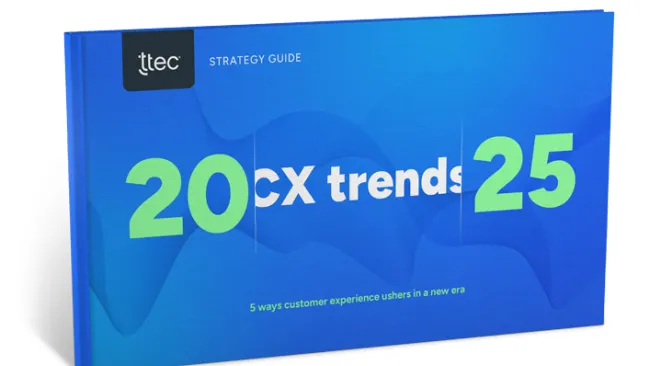The COVID-19 crisis has accelerated many variables in the marketplace. Digitalization is on the rise and work has turned on its head. But the need for customer experience, creating exceptional moments that matter hasn't changed—rather it’s amplified.
According to best-selling New York Times author Shep Hyken, customers no longer compare brands to direct competitors. They compare them to the best service they have ever received. In the TTEC webinar, Rise above the chaos in uncertain times, Hyken discussed what it takes to foster loyalty and brand devotion beyond crisis.
Here are four strategies that are critical for all industries to take charge of uncertainty and create amazing customer moments.
1. Strive to be amazing
Good is not good enough. Fostering an amazing customer experience begins with the mentality of being above average.
Moments that stand out to customers are when employees step up and show a degree of responsibility during an interaction, no matter how basic. This does not mean your customer service must be pushed to the extreme by over-pleasing. Rather, you want to encourage a mentality where your organization is predictably and consistently better than satisfactory.
This is the relationship-building, the daily hellos, the memory of the individual shopping habits. It is easy for an organization to shine in an emergency, but those who were constantly wow-ing just a little bit every step of the way will be remembered by customers who will return again and again.
2. Show your know-how
Wonderful interactions need to be backed by reliability. In the CX world, being knowledgeable means being credible. It’s essential that your employees demonstrate competency by deploying quick and ready information regarding products and services. Investments in automation will be an important asset to help support and deliver product and service information to associates. Think of automation like a virtual coworker for the future of work.
On the people side, not understanding your customer is unacceptable with the data that can be garnered from every interaction. A well-performing CRM system can give your employees an idea of past interactions, shopping habits, and sentiment. This will help employees predict questions and proactively meet their needs.
Showing off your knowledge on all fronts not only allows you to meet your customer’s needs, but it lets you make a connection that builds trust and credibility that will carry on.
3. Be consistent everywhere
Consistency is the reliability you can deliver every time around the products, channels, and customers you interact with daily. Building familiarity and comfort around these fronts is essential to securing customer loyalty.
The product: This is simply the quality of your service every day. Someone will always be judging your product. at times it goes well and sometimes it does not. That is to be expected. When the product experience fails, you need to be consistent with how you amend the problem.
The channel: Customers are no longer committed to a single channel. In today’s increasing digital environment, an interaction can shift from voice to messaging to email. This means that there are different expectations for every channel, varying hold times, and tones people take. So how do you make it consistent?
Work to define what is a ‘quick’ experience is in that channel. Understanding that a customer can be messaged back in five minutes on Facebook Messenger compared to an immediate voice response is key to knowing how to set the expectations for every interaction. Likewise, match the cadence or tone expected in different channels.
The people: In a true omnichannel environment that shifts between channels, employees need to deliver the same consistency of energy and professionalism as the last person. This goes into understanding that whomever you bring on has the drive to deliver amazing experiences that matches the tone of the product they sell and the channel they are on.
4. Use AI to unlock authenticity
AI is a powerful tool that can automate basic interactions and deflect interactions. But in times of crisis, there is a desire to speak interact with other people digitally rather than being pushed aside by a machine. This presents an opportunity to show off how intelligent automation can better assist human interactions.
People will always be needed to solve complicated, sometimes highly emotional, interactions. But AI can step in serve relevant information from knowledgebases and read off past interactions to help work alongside the employee. We used to be concerned about AI replacing people, what we need to focus on instead is how AI can make people’s jobs better.
5. Understand what makes you convenient
Convenience is the ultimate disruptor. It’s the driving factor that put Amazon and Uber on top of their industries and what others try to replicate. In our digital age, it needs to be easier than ever for customers to communicate with a brand. This is based upon Hyken’s ‘Six Convenience Principles’:
1. Reduce friction: The best pathway for customers is the experience with as few steps as possible. Brands like Uber make it easy because the entire interaction is comprised of a minimum number of clicks. Stress-free experiences are ones that customers will come back to repeatedly.
2. Self-service: Customers should have the option to take matters into their own hand. Self-service needs to be a customer support option as well as a way for people to research products.
3. Technology: The applications you deploy need to drive a seamless and effortless experience. Utilize online tools to make simple tasks, such as booking appointments, as easy as logging online.
4. Subscription: Use this model to enforce recurring consistency with your products and services. The subscription model is meant to lessen recurring physical visits and steps online.
5. Delivery: Make your interactions, physical and online, opportunities to delight by being there through every step of the journey. From ordering to at the customers doorstep.
6. Access: Be convenient and easy to do business with. Ask yourself how easy would it to be for a customer to get ahold of your employees at all hours, on all channels.
Understanding how these core aspects of a business work together are essential for building customer loyalty.
If you want to hear an in-depth conversation on these strategies listen to the full webinar, Rise above crisis in uncertain times, to learn about what it takes to deploy meaningful customer moments beyond the unknown.















